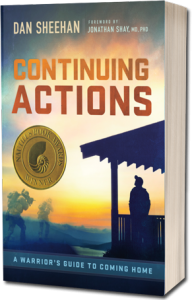Continuing Actions Epilogue and Conclusion
EPILOGUE
THOSE WHO’VE FOUGHT in Iraq and Afghanistan have an historic opportunity to redefine the veteran’s experience for future generations of American warriors. How? By approaching the challenges of coming home as integral components of the warrior’s journey, not as aberrations that only affect the weak.
America’s relationship with her veterans has matured to a point where invisible wounds are socially understood to be unavoidable consequences of sending troops to war. It is time we, as veterans, do the same. The reality of combat has changed each and every one of us in fundamental ways. If we take the opportunity afforded us by the current political and social atmosphere to understand these changes, we stand to become better men and women, fathers and mothers, brothers and sisters, husbands and wives, friends, and citizens.
This opportunity did not happen overnight. It was created by the tireless efforts of generations of American veterans—past and present. The warriors who came before us labored long and hard to secure the social, political, and economic support we enjoy today. Lest we take this support for granted, we should remember that America has not always been so inclined to care for those who fight her wars. Consider these facts, catalogued in James Wright’s excellent work, Those Who Have Borne the Battle:
—1783: Congress refuses to fund pensions already promised to Continental Army officers for service during the Revolutionary War. A coup by Continental Army officers is narrowly avoided by George Washington’s personal intervention. (p.25)
— In reaction to petitions from individual veterans with claims of Revolutionary War related injuries, the Congressional Committee on Claims stated: “Congress cannot undertake the support of paupers merely because they may have been at some period of their lives engaged in the public service.” (p.67)
—“No uniform pension for all surviving members of the War of 1812 existed until 1871 . . .” (p.76)
—“Congress approved comprehensive pensions for all [1846] Mexican War veterans in 1887.” (p.77)
—In 1932 a group of some 20,000 veterans and their families assembled in Washington DC to peti- tion the government for early payment of a bonus promised to veterans of WWI. Army Chief of Staff Douglas MacArthur “. . . personally led mounted cavalry commanded by George Patton, tanks, and infantry with tear-gas canisters and bayonets to expel the veterans.” (p.93)
Take a look at how far we’ve come. In 1932, in the worst of the Depression, our own military, under orders from the President, attacked veterans with tanks, bayonets, and tear-gas because they were asking for early payment of an already agreed upon bonus. Contrast that with the fact that, in 2014, a scandal concerning wait times at the Phoenix Veterans Affairs Medical Center ignited a public outcry that resulted in the resignation of VA Secretary Shinseki less than two months later. A month after that, President Obama signed a bill into law appropriating an additional $16 billion to overhaul the VA.
Bayonets and tanks on one hand, accountability and more money on the other. These two examples show the evolution of America’s relationship with her veterans and highlight the importance and primacy of veterans’ affairs in current political dialogues.
Far from having to scrabble for pensions and bonuses, today’s veterans have a wealth of opportunities waiting for them. Want to go to school? The Post 9-11 GI Bill is there to pay for it. How about starting your own business? The Small Business Administration has a whole department dedicated to helping veterans accomplish this. Need a house loan? Veterans are eligible for those as well. Medical care remains a challenge for veterans, but, given the disarray of our healthcare system as a whole, that problem is not limited to VA facilities.
Even though challenges remain, the benefits available to today’s veterans are wide-ranging and comprehensive. Perhaps even more importantly, they are provided ungrudgingly by the vast majority of society. These benefits are not considered as gifts to be doled out or withdrawn at will, but rather as a national obligation to those few Americans who choose to serve.
The organization directly responsible for fulfilling this national obligation is far from perfect. But as a governmental bureaucracy, the VA has demonstrated laudable willingness to address internal shortcomings and is making honest efforts to correct them—even if its feet must be held to the fire to do it. And with veteran service organizations and organized veterans’ groups wielding increasing political power, the problems at the VA are being corrected faster than ever before.
But improving veterans’ reintegration will take more than just fixing the VA. It will require changes in how we as a nation view the human costs of sending men and women to war. These adjustments have to occur on multiple levels: from the individual veteran’s understanding of how their experiences changed them, to the political wisdom to consider all the costs of conflict before engaging, to American society’s sharing of the burdens they’ve asked their military to assume in their name.
Most of those changes are beyond our ability to influence directly. Changing American society and injecting wisdom into political discourse are difficult, if not impossible, for most veterans to accomplish on their own. The improvements in those areas will take years of gradual adjustments if they happen at all.
But there is one area where each and every veteran can have a direct impact: the individual level. If we accept the concept that our duties as warriors do not end until we’ve met the challenges of coming home, then we stand to positively impact the reintegration of all veterans—now and in the future. Once we’ve done the hard work to process and learn from our own experiences, then we are in a position to apply our hard-earned wisdom to any number of political, social, and cultural problems. In this manner, the successful return of one veteran can be multiplied thousands of times as he or she shares their boon with their circle of influence, however large or small it may be.
This bottom-up approach has been overlooked in the current national dialogue about veterans. This is likely because few are willing to say that veterans have the ultimate responsibility to navigate the challenges of coming home. Others are willing to help, but each and every one of us has to be the driving force behind our own successful return. There is no other way.
This book draws heavily from my own experiences to illuminate a pathway through the challenges of coming home, but my path is not the only one that exists. You may find different tools to use and different routes to take and, indeed, I hope you do. If this book does no more than spark conversations between veterans who measure my efforts and find them ineffective against their own, then I will consider it an unqualified success. It would be the open sharing of what worked for them, and the fact that the conversation happened at all, that would signal progress for veterans as a whole.
Our service to the nation did not end when we took off our uniforms. By spreading out through society as healthy, well-adjusted veterans, we stand to influence not only our immediate family and friends with our wisdom and maturity, but also the fortunes of the nation as a whole. Crisis and conflict will always be part of our world, and future generations of American men and women—our children—will have to deal with them. Rest assured, they’ll shoulder the burdens of service and take the fight to our enemies, just like we did. Then they’ll come home and realize their challenges are not over, just like we did. The military will teach them what they need to know to fight and win. It will be up to us to teach them how to fully come home. The only way we can do that is if we’ve done it ourselves.
CONCLUSION
THE WARRIOR’S JOURNEY—the hero’s journey—is nothing more than a label placed on the particular branch of human consciousness that has carried strong men and women through life-changing experiences since the dawn of time. This book has tried to explain how this current influences your life and how you can better navigate its twists and turns by becoming an active participant instead of a passive observer.
What lies at the end of this journey? Well, death. That’s because the warrior’s journey continues for as long as you live. It’s a circle you’ll pass through many times in your life on slightly different trajectories. If you develop and maintain the self-awareness borne of honest introspection, the challenges of each revolution will teach you different valuable lessons, and you’ll continue to grow in maturity and wisdom. By refusing to stagnate, you stand to live a meaningful, fulfilled life surrounded by people who love and cherish you—faults and all.
It is my sincere hope that your life as a veteran is consciously guided by what you’ve learned from your experiences in uniform. Hard lessons about the value and fragility of life, often written in the blood of our heroes, should never be forgotten.
If nothing else matters to you, think about this. When you do die, when you finally link-up with your buddies who fell in battle, how do you want them to greet you? Will they shake their heads at how you pissed away the opportunities they were denied? Will they berate you for remaining mired in the past and ruining your chances for happiness?
Or will they greet you with a proud smile and a chest-crushing embrace? When the thudding, closed-fisted, back-pounding is done and the tears self-consciously wiped away, will they take a step back, hold you at arms length and say:
You did good, real good.
I don’t know. But that’s what I’m going for.
THE END



